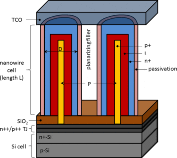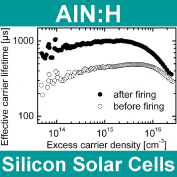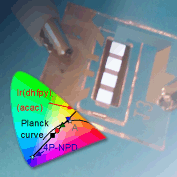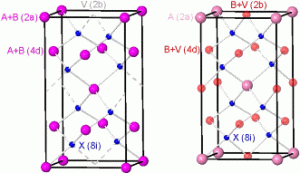Welcome to the latest selection of recent top articles in the physica status solidi journals. Get a glimpse of our publication spectrum and visit our pages by clicking on any of the DOI links below.
III–V nanowire photovoltaics: Review of design for high efficiency [Review@RRL]
R. R. LaPierre, A. C. E. Chia, S. J. Gibson, C. M. Haapamaki, J. Boulan-ger, R. Yee, P. Kuyanov, J. Zhang, N. Tajik, N. Jewell, and K. M. A. Rahman
 To overcome the limitations of current III–V multi-junction solar photovoltaic (PV) cells, III–V nanowire-based PV is being aggressively pursued by numerous groups. This article provides a comprehensive review of nanowire-based PV covering all aspects of design for high power conversion efficiency including nanowire growth methods, growth direction, crystal structure, optical absorption, carrier collection, strain accommodation, tunnel junctions, Ohmic contact formation, passivation and doping.
To overcome the limitations of current III–V multi-junction solar photovoltaic (PV) cells, III–V nanowire-based PV is being aggressively pursued by numerous groups. This article provides a comprehensive review of nanowire-based PV covering all aspects of design for high power conversion efficiency including nanowire growth methods, growth direction, crystal structure, optical absorption, carrier collection, strain accommodation, tunnel junctions, Ohmic contact formation, passivation and doping.
Phys. Status Solidi RRL (2013) DOI 10.1002/pssr.201307109
Study of hydrogenated AlN as an anti-reflective coating and for the effective surface passivation of silicon [Rapid Research Letter]
Georg Krugel, Aashish Sharma, Winfried Wolke, Jochen Rentsch, and Ralf Preu
 The passivation of the front and rear surface of a solar cell is a key feature to reach higher efficiencies. The authors show that sputtered AlN:H can be used as a passivation layer. Excellent passivation with lifetimes exceeding 1 ms is presented. This is traced back to a very low defect density and a high density of fixed charges at the interface to silicon. Furthermore, interesting optical properties are shown for these layers which make them an ideal material for a combined passivation layer and anti-reflective coating.
The passivation of the front and rear surface of a solar cell is a key feature to reach higher efficiencies. The authors show that sputtered AlN:H can be used as a passivation layer. Excellent passivation with lifetimes exceeding 1 ms is presented. This is traced back to a very low defect density and a high density of fixed charges at the interface to silicon. Furthermore, interesting optical properties are shown for these layers which make them an ideal material for a combined passivation layer and anti-reflective coating.
Phys. Status Solidi RRL (2013) DOI 10.1002/pssr.201307135
Investigation of triplet harvesting and outcoupling efficiency in highly efficient two-color hybrid white organic light-emitting diodes [Advanced Materials Physics]
Simone Hofmann, Mauro Furno, Björn Lüssem, Karl Leo, and Malte C. Gather
 Singlet and triplet transfer processes are studied in white triplet harvesting organic light-emitting diodes, comprising fluorescent and phosphorescent emitter molecules. The CIE coordinates of these devices can be adjusted over a wide range by varying the distance between exciton generation and triplet harvesting zone. Optical modeling of the electromagnetic field and a comparison to the position of the emitters confirms that the devices operate close to the optical optimum.
Singlet and triplet transfer processes are studied in white triplet harvesting organic light-emitting diodes, comprising fluorescent and phosphorescent emitter molecules. The CIE coordinates of these devices can be adjusted over a wide range by varying the distance between exciton generation and triplet harvesting zone. Optical modeling of the electromagnetic field and a comparison to the position of the emitters confirms that the devices operate close to the optical optimum.
Phys. Status Solidi A (2013) DOI 10.1002/pssa.201329107
Simulations of photocurrent improvement through combined geometric/diffracting light trapping in organic small molecule solar cells [Original Paper]
Marcos Soldera, Emiliano Estrada, and Kurt Taretto
 The photocurrent delivered by organic solar cells is drastically limited by optical losses due to insufficient light trapping, parasitic absorption in the contact layers, and reflectance. Soldera et al. simulated two- and three-dimensional surface textures in the micro- and submicroscale to improve light trapping in optimized organic solar cells based on copper phtalocyanine (CuPc) and fullerene (C60). The analysis was carried out with the aid of the finite element method, taking into account interference as well as reflection and diffraction of the incident AM1.5 spectrum. At normal incidence, up to 23% improvement in the photocurrent over the planar cell was obtained.
The photocurrent delivered by organic solar cells is drastically limited by optical losses due to insufficient light trapping, parasitic absorption in the contact layers, and reflectance. Soldera et al. simulated two- and three-dimensional surface textures in the micro- and submicroscale to improve light trapping in optimized organic solar cells based on copper phtalocyanine (CuPc) and fullerene (C60). The analysis was carried out with the aid of the finite element method, taking into account interference as well as reflection and diffraction of the incident AM1.5 spectrum. At normal incidence, up to 23% improvement in the photocurrent over the planar cell was obtained.
Phys. Status Solidi A (2013) DOI 10.1002/pssa.201228637
Order–disorder processes in adamantine ternary ordered-vacancy compounds [Original Paper]
F. J. Manjón, O. Gomis, R. Vilaplana, J. A. Sans, and H. M. Ortiz
 Adamantine ternary ordered-vacancy compounds (OVCs) of the AB2X4 family derive from the zincblende structure of binary AX com-pounds and share many properties with the chalcopyrite-type ternary ABX2 compounds. AB2X4 mainly crystallize in the defect chalcopyrite (or thiogallate) structure but also in other vacancy-ordered phases. Order–disorder phase transitions have been studied in several adamantine OVCs at high temperatures and/or pressures, where OVCs undergo a phase transition to a disordered zincblende structure on increasing temperature and to a disordered rocksalt structure on increasing pres-sure. It has been suggested that these order–disorder transitions should undergo via intermediate phases of partial disorder. Manjón et al. study the different possible intermediate phases and discuss the possibility to find them with the help of vibrational spectroscopy.
Adamantine ternary ordered-vacancy compounds (OVCs) of the AB2X4 family derive from the zincblende structure of binary AX com-pounds and share many properties with the chalcopyrite-type ternary ABX2 compounds. AB2X4 mainly crystallize in the defect chalcopyrite (or thiogallate) structure but also in other vacancy-ordered phases. Order–disorder phase transitions have been studied in several adamantine OVCs at high temperatures and/or pressures, where OVCs undergo a phase transition to a disordered zincblende structure on increasing temperature and to a disordered rocksalt structure on increasing pres-sure. It has been suggested that these order–disorder transitions should undergo via intermediate phases of partial disorder. Manjón et al. study the different possible intermediate phases and discuss the possibility to find them with the help of vibrational spectroscopy.
Phys. Status Solidi B (2013) DOI 10.1002/pssb.201248596
Structural, electronic and magnetic properties of the period vacancy in zigzag GaN nanoribbon [Original Paper]
Guo-Xiang Chen, Dou-Dou Wang, Jian-Min Zhang, and Ke-Wei Xu
 Chen et al. performed first-principles calculations on structural, electronic and magnetic properties of zigzag GaN nanoribbons (ZGaNNRs) with a period vacancy located at different sites across the ribbon width. The results show that the formation of the N-vacancy is easier than that of Ga-vacancy at each equivalent geometrical site and both of them are endothermic. An inward relaxation of the three nearest Ga atoms around N-vacancy occurs while for the three nearest neighbor N atoms around the Ga-vacancy, an outward relaxation occurs. Except a typical non-edge N-vacancy, the N- or Ga-vacancies at other sites induce magnetic moment and spin polarization implying that such va-cancy-defective ZGaNNRs can be useful in spintronics and nanomagnets.
Chen et al. performed first-principles calculations on structural, electronic and magnetic properties of zigzag GaN nanoribbons (ZGaNNRs) with a period vacancy located at different sites across the ribbon width. The results show that the formation of the N-vacancy is easier than that of Ga-vacancy at each equivalent geometrical site and both of them are endothermic. An inward relaxation of the three nearest Ga atoms around N-vacancy occurs while for the three nearest neighbor N atoms around the Ga-vacancy, an outward relaxation occurs. Except a typical non-edge N-vacancy, the N- or Ga-vacancies at other sites induce magnetic moment and spin polarization implying that such va-cancy-defective ZGaNNRs can be useful in spintronics and nanomagnets.
Phys. Status Solidi B (2013) DOI 10.1002/pssb.201349124

















